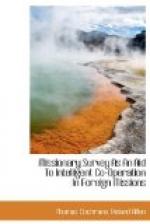-------------------------------------------------------
-+------| Population. | | --------------------------------------------------------+---
---| Illiterate Population. | | --------------------------------------------------------+---
---| Number of Teachers of Illiterate Adults. | | --------------------------------------------------------+---
---| Number of Illiterate Adult Scholars. | --------------------------------------------------------+---
---| Christian. | | --------------------------------------------------------+---
---| Non-Christian | | --------------------------------------------------------+---
---| Proportion of Illiterate Population. | --------------------------------------------------------+---
---| Proportion of Teachers to Illiterate Population. | | --------------------------------------------------------+---
---| Remarks and Conclusions. | | --------------------------------------------------------+---
---|
This table leads us naturally to consider the educational work done in the station area from an evangelistic point of view. We must inquire then into the extent to which evangelistic missionaries assist in the schools, and educational missionaries assist in evangelistic work, and the evangelistic results so far as they can be traced of the work in schools.
We ask first the extent to which educationalists employ the services of evangelistic workers in their schools and institutions. As we pointed out in dealing with the relation between medical and evangelistic work, so here we would insist that this particular table is not by itself a good guide. There is a serious danger in an institution, whether medical or educational, of dividing the work in this way. We have already asserted our conviction that medical missionaries should be evangelistic, and educational missionaries evangelistic also. But when evangelistic workers distinctly so called are on the staff of hospitals or schools, there is a danger lest the medicals and the educationalists should consider themselves absolved from personal effort by the occasional presence of an evangelist. “Let him do the religious preaching, and let me do the secular teaching. Preaching is his job, teaching is mine.” Thus a division is created which reacts seriously upon the work of both. The pupils learn to distinguish the one work from the other, as separate and distinct departments. They prefer the one, they are bored by the other. No man can serve two masters; and if the religious teaching is plainly in the hands of one teacher and the secular teaching plainly in the hands of the other, they will tend to think that they can hold to the one and despise the other. This we say is a danger, but it is not an unavoidable danger. Only we must not judge that an institution is doing good evangelistic work because evangelistic services are held in it. The table is as follows:—




